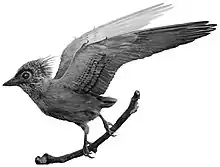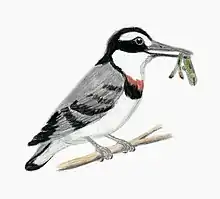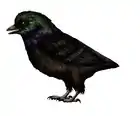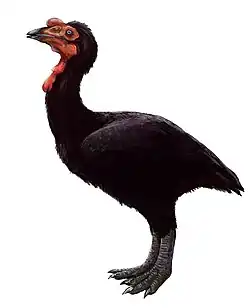Neuquenornis
Neuquenornis volans[1] is a species of enantiornithean birds which lived during the late Cretaceous period in today's Patagonia, Argentina. It is the only known species of the genus Neuquenornis. Its fossils were found in the Santonian Bajo de la Carpa Formation, dating from about 85-83 million years ago. This was a sizeable bird for its time, with a tarsometatarsus 46.8mm long. Informal estimates suggest that it measured nearly 30 cm (12 in) in length excluding the tail .
| Neuquenornis Temporal range: Late Cretaceous, | |
|---|---|
| Scientific classification | |
| Domain: | Eukaryota |
| Kingdom: | Animalia |
| Phylum: | Chordata |
| Clade: | Dinosauria |
| Clade: | Saurischia |
| Clade: | Theropoda |
| Clade: | Avialae |
| Clade: | †Enantiornithes |
| Family: | †Avisauridae |
| Genus: | †Neuquenornis Chiappe & Calvo 1994 |
| Species: | †N. volans |
| Binomial name | |
| †Neuquenornis volans Chiappe & Calvo 1994 | |
Etymology
The naming means "Flying bird from Neuquén Province".[2] Neuquenornis, from Neuquén Province + Ancient Greek ornis (όρνις) "bird". volans, Latin for "flying" in reference to the species' well-developed wing skeleton.
Description
N. volans was described by Chiappe and Calvo in 1994. It was also mentioned in previous papers by Chiappe, but named only by its catalog number. The holotype fossil is catalogued as MUCPv-142. It is in the collection of the Museo de Ciencias Naturales, Universidad Nacional del Comahue, Neuquen, Argentina. MUCPv-142, a skull and a partial postcranial remains, indicates an animal with a length of 23.5 cm (9.3 in), hip height of 17 cm (6.7 in), and weight of 205 g (7.2 oz).[3]
Phylogeny
Chiappe and Calvo (1994) placed N. volans in the Family Avisauridae, near Avisaurus in the Enantiornithiformes. A more recent, unpublished, unreviewed, analysis that includes many newly described Enantiornithes[4] finds it closer to Concornis and Cathayornis (or Sinornis).
The cladogram below is from Wang et al., 2015:[5]
| Ornithothoraces |
| ||||||||||||||||||||||||||||||||||||||||||||||||||||||||||||||||||||||||||||||||||||
The cladogram below is from Wang et al., 2022:[6]
| Enantiornithes |
| |||||||||||||||||||||||||||||||||||||||||||||||||||||||||||||||||||||||||||||||||||||||||||||||||||||||||||||||||||||||||||||||||||||||||||||||||||||||||||||||||||||||||||||||||||||||||||||||||||||||||||||||||||||||||||||||||||||||||||||||||||||||||||||||
| l |
Key to letters:
b = Boluochia
c = Cathayornis
e = Enantiophoenix
f = Houornis
h = Longipteryx
i = Parabohaiornis
j = Pterygornis
l = Vorona
m = Yuanjiawaornis
n = Yungavolucris
Paleobiology
Long legs with hooked claws were well suited for perching as well as for пathering food on ground or shallow water.[2] A nesting colony has been attributed to this bird, showcasing that it display megapode-like egg burial behaviour.[7]
References
- Chiappe, Luis M.,Calvo, Jorge O. (1994) "Neuquenornis volans, a New Late Cretaceous Bird (Enantiornithes: Avisauridae) from Patagonia, Argentina""Journal of Vertebrate Paleontology" Vol. 14, No. 2 (Jun. 22, 1994), pp. 230-246 https://www.jstor.org/stable/4523563
- Matthew P. Martyniuk (2012). A Field Guide to Mesozoic Birds and Other Winged Dinosaurs. Pan Aves. p. 142. ISBN 9780988596504. Retrieved 29 August 2022.
- Rubén Molina-Pérez, Asier Larramendi, David Connolly, Gonzalo Ángel Ramírez Cruz, Andrey Atuchin (June 25, 2019). Dinosaur Facts and Figures: The Theropods and Other Dinosauriformes. Princeton University Press. p. 281. ISBN 9780691190594. Retrieved 29 August 2022.
{{cite book}}: CS1 maint: multiple names: authors list (link) - Mortimer (2004)
- Wang, Min; Hu, Han; Li, Zhiheng (21 August 2015). "A new small enantiornithine bird from the Jehol Biota, with implications for early evolution of avian skull morphology". Journal of Systematic Palaeontology. 14 (6): 481–497. doi:10.1080/14772019.2015.1073801. S2CID 83603202.
- Wang, Xuri; Cau, Andrea; Luo, Xiaoling; Kundrát, Martin; Wu, Wensheng; Ju, Shubin; Guo, Zhen; Liu, Yichuan; Ji, Qiang (2022-02-11). "A new bohaiornithid-like bird from the Lower Cretaceous of China fills a gap in enantiornithine disparity". Journal of Paleontology. 96 (4): 961–976. doi:10.1017/jpa.2022.12. ISSN 0022-3360. S2CID 247432530.
- Fernández, Mariela S.; García, Rodolfo A.; Fiorelli, Lucas; Scolaro, Alejandro; Salvador, Rodrigo B.; Cotaro, Carlos N.; Kaiser, Gary W.; Dyke, Gareth J. (2013). "A Large Accumulation of Avian Eggs from the Late Cretaceous of Patagonia (Argentina) Reveals a Novel Nesting Strategy in Mesozoic Birds". PLoS ONE. 8 (4): e61030. doi:10.1371/journal.pone.0061030. PMC 3629076 Freely accessible. PMID 23613776.
Further reading
- Mortimer, Michael (2004a): The Theropod Database: Phylogeny of taxa. Retrieved 2013-MAR-02.
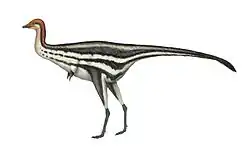
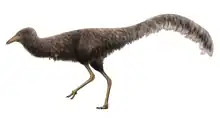


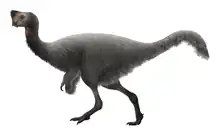
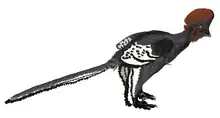


.png.webp)


.jpg.webp)
